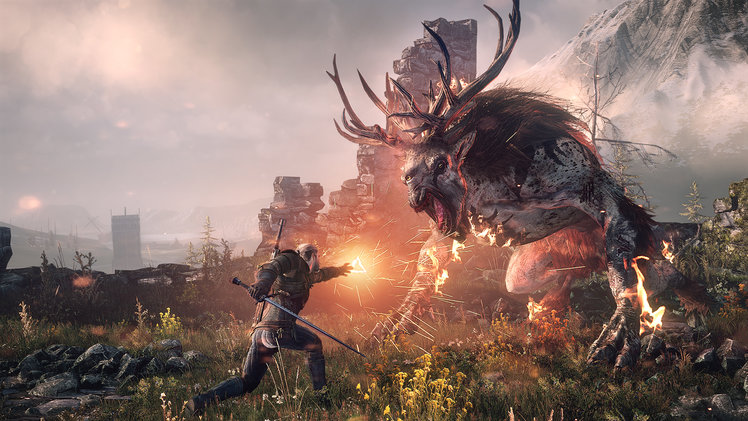
For role-playing game fans it’s only once in a blue moon a title comes along that’s so engrossing you’ll willingly surrender not just a little bit of time to play it, but days and weeks of your life. The Witcher 3: Wild Hunt is a prime example; a captivating game that, for our money, is the best RPG since Skyrim.
But, if anything, it’s a little bit more grown-up than that 2011 Bethesda epic. There’s a lot more f-ing and blinding for starters, the occasional c-bomb included. And much more blood. Oh, and let’s not forget the smattering of nudity. Yep, Witcher 3’s adult themes are quickly established from the moment the camera lingers on a bare derrière mere minutes into the game. Yet – and despite that reading like an apparent Hollywood “sex, blood, swearing, – buy, buy, buy!” kind of campaign – it’s not gratuitous, rather more representative of a believable world. Y’know, one where mages and magic are a normality.
It’s also a timely release. With millions of Game of Thrones fans the world over, there are inevitable comparisons – c’mon, even Charles Dance, voice of Tywin Lannister in Game of Thrones, voices Emperor Emhyr var Emreis here – despite Andrzej Sapkowski’s short stories preceding those of George RR Martin.
But whether you’re an existing fan, a newcomer, or someone who’s looking to replay the game on Nintendo Switch (that’s why we’re updating this review), the swordplay, magic, monsters and fire gods certainly make for damn good entertainment. So, attention grabbed, nipples acknowledged, we’ve spent dozens of hours delving into The Witcher 3: Wild Hunt’s world, exploring its decision-based storyline, side missions and sprawling landscapes. Here’s why, whether you’re a fantasy fan or not, it’s still a stone cold classic of RPGs.
One giant beast
When it arrived back in 2015 there was no game of the same epic scale as The Witcher 3. Even now, five years later, it’s still a huge world to explore. The open landscape throws you into a world of magic and combat, led by enticing characters and great acting that will keep you hooked. Ok, so Geralt, the witcher you play, might’ve been listening to Christian Bale’s Batman a little too much, but his husky voice becomes part of the game’s charm.
After the main cutscene kicks-off proceedings – in hand-drawn graphic novel style with story narrator, a theme that continues with each loading and progress scene, but that feels distant from the style otherwise used within the game – the story begins with you seeking Ciri, your adopted daughter, who, for reasons unknown at the time, the evil Wild Hunt seek.
It’s from here the basics of combat are learned, in a flashback to Ciri’s childhood. But there’s a whole lot to master, which takes time to then apply effectively in the game. The Witcher 3 is no plodding turn-based role-player: you’ll need to attack in fast-paced, real-time scenarios. It’s not all slash, slash, slash button bashing either; parry, dodge and use of stronger sword attacks in combination deal with different foes. Other sword-bearing folk tend to be easily dispatched, but groups of wraiths, ghouls and the like will demand well-timed rolls and dodges to get around.
To add to the mixing pot there are a variety of magical spells that are essential for tactical attack and defence – particularly when ensconced by a group of enemies. And let’s not forget additional items, including crossbows and bombs, that come in handy for certain combat… or just sheer provocation.
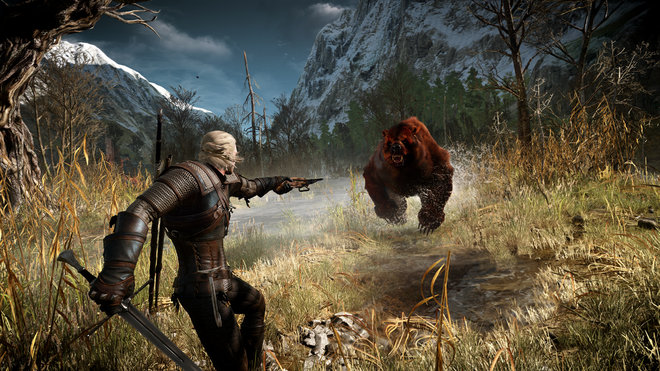
All this has the makings of a deep role-player, but that’s just the tip of the iceberg really. You’ll later learn crafting and alchemy, trading, and how to apply experience points to specific character enhancement trees (earned from quests, resulting in your levelling-up), all of which are essential to the game. Whether you chose the path of warrior, alchemist or magician is down to the choices you make when applying upgrades. Enhancements can also be multiplied with mutagens, sourced from specific enemy kills.
Horsing around
In the first instance the game’s controls feel a little too heavy – something we still think to this day, especially when it comes to horseback riding – but it’s something you’ll get used to. Well, after trying to climb up rather than run around a damn ladder for the fifth time. Controlling Geralt doesn’t feel as smooth as playing, say, Grand Theft Auto 5, nor is there the deftness of Assassin’s Creed when it comes to jumping gaps or climbing. But those are entirely different games, ones we’ve played enough of and enjoyed for what they are.
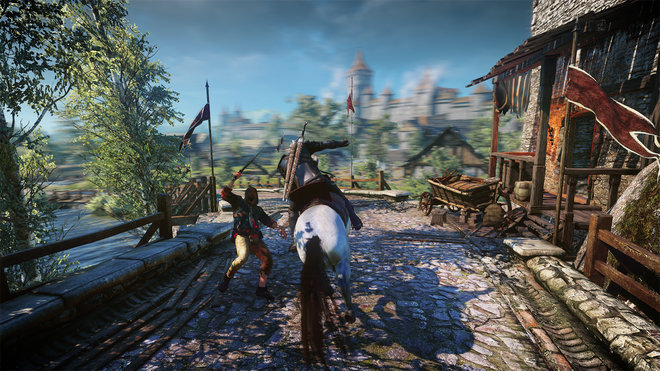
And to be fair, Geralt is wearing armour, which must be pretty hefty given how his horse, Roach, handles. An essential element to the game given its scale, you’ll need to use your steed to navigate more swiftly through the landscape. Just watch out for dips, walls and even some trees, which will catch you out and slow you down, often to a stop. In busier areas we’re often inclined to just run around on foot rather than via hooves for simplicity’s sake. Roach could definitely be more fluid in control, and despite a double-tap-to-follow-the-road mechanic, he’s not got the brains to always head to your desired location. That’s horses for you: neigh respect.
Traversing such a giant landscape can take a long time too. Fortunately there are fast travel signposts, discovered as you enter relevant areas – whether crossroads, towns, cities, hideouts, caves, and so forth – after which they appear on the world map. This brown-paper guide of the Witcher world is so big it would unfurl like a comical quadruple-size broadsheet newspaper. It’s mind-boggling just how massive this game is: think Skyrim and then multiply that by three.
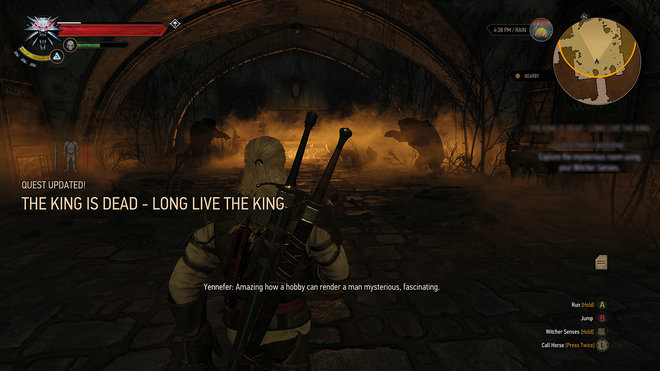
It’s essential, therefore, to make use of the miniature version that hovers top-right of screen. Problem is, some core nearby points of interest (such as nearest fast travel signpost) don’t show-up if they fall outside of this small circle, so you’ll be menu digging a little more than you ought to. And fast travel signposts aren’t as plentiful as they should be, particularly from some positions within the game.
Level-up!
Once you’ve got stuck into the main storyline – and no spoilers here – you’ll quickly encounter multiple quests that show-off the game’s breadth. You can spend excessive time playing cards – “gwent”, a complex card game that we still aren’t hugely interested in, but which since spawned its own separate dedicated game for mobile – or search out that rare herb needed for a potion. Sound too boring? Go explore a waterside and cut the heads and limbs off some drowners and ghouls instead. Or craft some armour.
It all makes for a rich tapestry of gameplay that doesn’t throw you in at the deep-end, nor become single-minded in its approach. There are four levels of difficulty, varying from accessible to bastard-hard, which can be changed at any point in the game too. If you don’t master dodging and parrying, though, then best stick to the middle-to-lower settings.
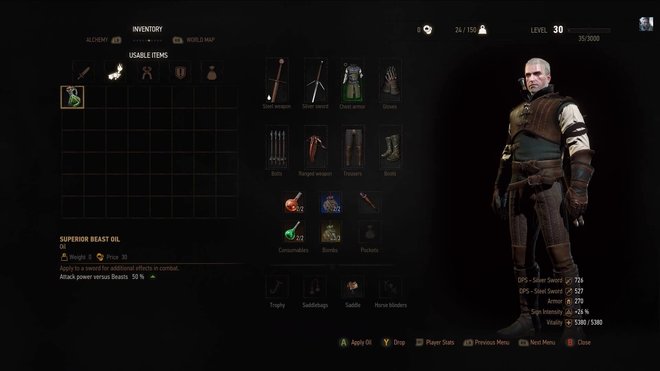
If the lead missions are getting too tough then you’ll need to hold back your progress, explore some more to gain additional experience points and level-up your abilities. Enemies show a power bar alongside a number, the latter which represents their level. If you’ve achieved, say, level 10 and your foe are at a similar level then you’re in good shape to take them down.
However, the more enemies there are in a group, the tougher that can be. Avoid backing yourself into a corner otherwise you’ll find The Witcher 3’s biggest stumbling block: a perilous auto camera that can really work against you, particularly when fighting indoors. With groups you’ll do well to deploy Bloodborne tactics: separate the larger groups into individuals or smaller groups. Monsters tend to attack en masse (which can be annoying when four drowners strike you simultaneously) whereas human opponents usually hold their ground, often goading you forward with come-hither hand movements.
Don’t fret if an enemy is four levels or so above your level though. If they’re guaranteed to be beyond your abilities then a red skull symbol will also show above their level – essentially telling you to get the hell out of there.
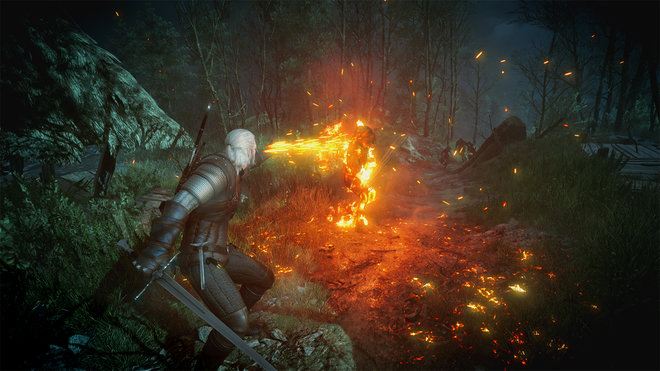
There’s one big issue here though: if you’ve entered a mission where there’s no escape, and it’s a level well beyond your means, you best make sure you’ve manually saved prior, otherwise there’s no getting out of there. Which can be a total shutdown.
Like a boss
Things change pace even more when boss characters are encountered. You’ll work your way up to each of them, but some will take a couple of goes to take down. If you get stuck then the bestiary – a glossary of beasts and their weaknesses, found in your inventory – can be helpful, assuming you’ve acquired the relevant foe’s details from a previous quest.
Bosses are typically giant and have faces that would make small children cry. But we’ve already established it’s not a game for the lil’uns, so enjoy those ferocious wyvern beaks, three-eyed fiends, and gross-out botchlings. And try not to cry too much when they dispatch you.
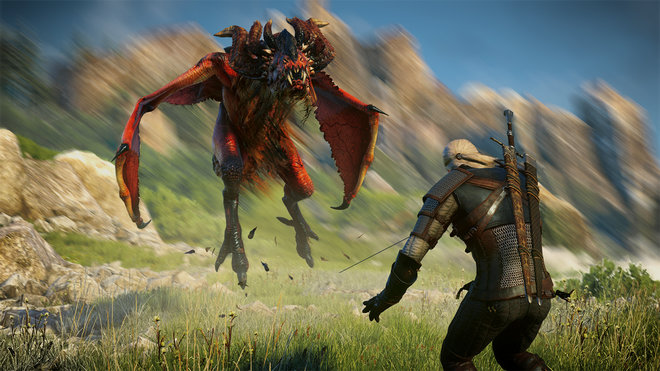
Typically magic and potions are the way to forge ahead in the big fights. Alchemy can be performed on the road, so you needn’t find a specific location to create new bombs, potions and oils. Looting for these ingredients is the best way to come about things – and, in our game, nobody bar guards seem to give a hoot about us stealing everything – but the alchemy panel can become heavy with a barrage of items in little time (which slows down loading and navigation).
For armour and weapons, however, you’ll need to find the relevant armourer or blacksmith of the right skill to craft. There are portable repair kits, found infrequently, that you’ll want to use only at the essential moments. Swords damage quickly too, so it’s a good job your standard duo – silver for monsters, steel for humans – can be supplemented with as many additions, axes, maces, and so forth, as you want (subject to maximum weight). Looking after weapons can cost you a pretty penny; the primary use of extra ones is to dismantle them and acquire the resulting goods for crafting better items.
Gorgeous details
The Wild Hunt is the first Witcher game to make its way to consoles, with Xbox One and PlayStation 4 versions joining the PC copy – and theNintendo Switch joining the party in 2020 too. The reason is obvious: there are graphical flourishes that, PC excluded, wouldn’t have been possible without the new-gen consoles. Even the Switch does a darn good job overall, all things considered.
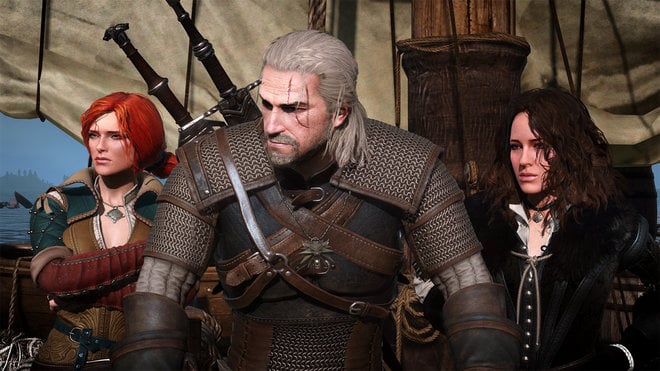
Some of the small things stand out in particular: the way the wind catches the trees; how sunlight breaks through the branches as a forest thins out; the flow of characters’ hair; even wet skin after a bath. Of course there’s better to be had out there, because the gaming world moves fast, and five years is a long time in any game’s life. Take a glimpse at CD Projekt Red’s forthcoming Cyberpunk 2077, for example, and prepare to be blown away.
There are moments atop a mountain when you can happily leave Geralt poised, listen to the excellent jingle-jangle lute-based soundtrack, and watch the time and weather change – typically resulting in a brewing storm and rain. Need to shift forward in time, then simply meditate to restore energy and potions, or grab a bit more sunlight.
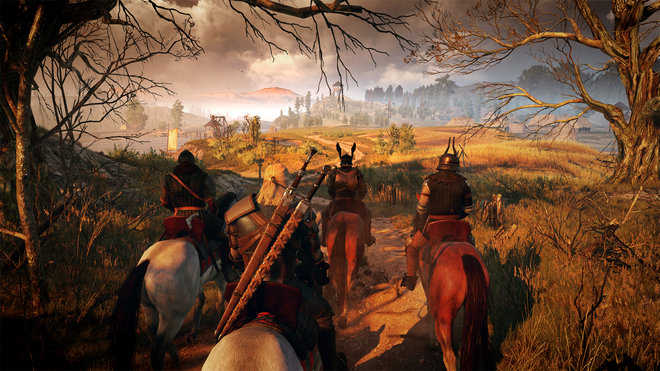
In addition to the great soundtrack the cast do a cracking job too. It’s not all down to Charles Dance, mind, but the majority British cast bringing all manner of islander tongues to the game, often with tongue-in-cheek impact that’ll bring a smile to your face. Shame the producers, CD Projekt Red, re-use many of the same faces for folk you meet on the way – it’s kind-of eerie – and that some characters, including rock trolls and witches, are borderline incomprehensible (you’ll be reading the subtitles). Oh, and almost all the children are inexplicably terrifying.
